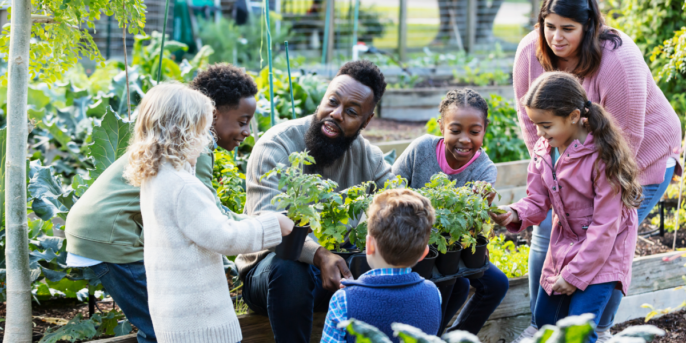Last fall, we announced our efforts to support the creation of learner-centered ecosystems. We shared our intention to study the insights and innovations around the systems change needed to make an ecosystem approach equitable in a diverse set of communities nationwide.
Creating this approach to public education will require systems change because the current K–12 system—including many of its structures, mindsets, and policies and how they relate and interact with one another—are not the most conducive conditions for learner-centered education to thrive. We know much more now than we did decades ago when much of our current system was conjured up, about how learning happens and what learners need. We believe ecosystems are, by design, a systemic way to incorporate and reflect what we know now about meeting individual learners’ holistic goals and needs, as well as simultaneously connecting and uplifting the collective good and communities overall.
Since this fall, we’ve gotten a lot of good questions about this work and the why behind our efforts. While the nature of some of the work is emergent, there is a lot we are eager to share.
Why Focus on Systems Change?
There have been incredible efforts and investments focused on transforming the public system in hopes that it is more conducive to supporting learner-centered education in all forms. I’ve spent most of my education career in public education, working on such efforts in schools and districts, ranging from pre-service teacher development and creating curriculum, to conducting research and studying and visiting innovative approaches across the country. Countless educators over the last several decades have done the same, all pushing for progress.
No doubt, over the years, we’ve witnessed positive results from these efforts that should not be neglected, including a strong network of learner-centered sites and leaders, practices, and resources supporting the approach, and a growing demand for the transformation of public education across the country. In my current role as Chief Innovation Officer at Education Reimagined, I continue to back these efforts and honor the leaders and practitioners who daily are providing learning experiences that foster agency, belonging, and develop meaningful competencies for young people.
Despite these continued and expanding endeavors, the system as a whole hasn’t radically changed to embrace learner-centered education. I’d argue it still remains true that most families in the public system do not have this kind of education as an option.
Why? Among other reasons, learner-centered sites with proven success are typically still embedded in conventional systems that can constrain their ability to grow and spread. Attempts to scale single-site approaches to other regions don’t always account for unique community contexts, cultures, wants, and needs. We need spreadable systems that enable the creation of environments that are designed for human development. Big Picture Learning is one example of a network that has succeeded in spreading to over one hundred sites while remaining true to the community within which the schools reside. That isn’t to say it’s impossible, but it is very hard to work within conditions that were not established to allow learner-centered education to flourish.
As a result, too few learners have access to learner-centered opportunities, let alone an ecosystem, despite more and more families expressing their desire for a connected and holistic system. The fact is, families with means or access often exercise those privileges to create and connect opportunities on their own or physically move to seek them out. This risks deepening inequities and creating unrealistic notions that parents (of any means) are supposed to curate their children’s education with little or no support. Further, how young people navigate their current worlds and how most learning happens today is growing to be increasingly more distributed and dynamic by the day. Meeting every learner’s needs is hard to do in a single school building. Even our best attempts at an improved conventional system just aren’t reflective of the times, or the future.
On the counter, ecosystems are designed to embrace flexibility, connection to place, entrepreneurism, and holistic outcomes that meet the needs of learners—all of which are values many express wanting in a modern public education system. To get a system that values these things, we need more than a refresh; we need to reinvent, which takes real systems change. Therefore, we realized we needed to investigate what system changes would enable ecosystems to equitably be a reality for families and learners. We saw a need for like-minded organizations to support communities that are demonstrating the system’s components—including assessment, roles, and governance models—that support ecosystems and aren’t aimed at only improving the current system.
If we want to see a transformed public system, we have to demonstrate what is possible. When it comes to such a pivotal institution like our public education system, we can’t all simply jump into the unknown. People need to see, touch, and feel what it would look like and the impact it will have. This will require researching, studying, and learning from systems and infrastructure being deployed in new ways. Innovation in this space will look like both developing new systems-level components that don’t yet exist, as well as utilizing existing systems approaches in new ways to lead to better outcomes for all learners. Fortunately, there is a growing body of wisdom, evidence, and examples of spreadable system-level components to learn from and leverage. There is also research that points to the power of this kind of system and what it could provide families and learners. Once we demonstrate and validate those possibilities as credible paths forward, we can begin to make clear that our current system is not the only way. We will have proof points of an alternative approach to public education.
If we want to see a transformed public system, we have to demonstrate what is possible.
Emily Liebtag
What will this R&D look like at Education Reimagined?
For over ten years, Education Reimagined has been hosting conversations, convenings, and working with communities wanting to transform public education. Our strategy has been aimed at helping them feel seen and realize the possibility of what they want in their communities and for young people. Partner organizations and colleagues have been doing the same, dedicated to this pursuit of seeding the possibility of a more equitable learner-centered system and helping communities make it happen on the ground.
We will continue this work, providing learner-centered leaders and communities with programs, language, and connection. Building the field of learner-centered education and spreading the vision for what is possible remains core to our strategy.
As a catalytic organization, we realized that we also need to add an intentional R&D effort around systems change to our strategy. I’m working with our team to take up that charge. I like to think of my role as helping to shape, shift, and see—shaping and implementing our strategy, shifting and pivoting when we learn new information, and seeing the possibilities as we support and learn alongside communities paving the path of a transformed public education system.
Adding a more intentional effort around systems change into our overall strategy will enable us to better support learner-centered leaders and advocates—both those operating within the current system and beyond. We will build upon the lessons learned with our community partners and growing network of leaders. We firmly believe that decision-making should be held by community members and that their wisdom must be centered in any change. Therefore, our work at Education Reimagined will aim to support communities in their ability to demonstrate ecosystems as viable, accountable, and sustainable. This will include finding people interested in learning more and supporting them in their journey towards systems change.
Along with partners who share a vision for learner-centered education, some of our work will include:
- Sharpening and spreading the vision, resources, and tools for learner-centered ecosystems
- Identifying, convening, and cultivating ecosystem builders
- Researching the theoretical underpinnings, conditions, technologies, and policies that support ecosystems
- Working with communities piloting and demonstrating systems-level components
- Gathering insights and evidence along the way around how to codify and mobilize the people, practices, conditions, and connections for spread
- Partnering with organizations to provide communities more specific assistance for ecosystems to grow and develop
- Marshaling the conditions and resources needed to support this work
The Promise Ahead
We have already been working to support communities dedicated to systems change and have elevated our initial learnings. Communities like FabNewport are demonstrating growing trust and confidence in another way to do K–12 education, engaging more and more families in their emerging ecosystem. At places like the PAST Foundation, leaders are deploying systems-level infrastructure around privacy and security as learners navigate in and out of physical and virtual spaces in their growing ecosystem. Big Thought in North Texas is showcasing how systemwide partnerships, spanning both public and private institutions, can amplify empowering experiences and connect youth to impactful skill-building opportunities.
We continue to discover and seek those ready to create what’s next and see the possibilities ahead. We want to learn alongside these communities in this effort. People often ask us what we think the future of education holds. My responses used to typically be about projects or design thinking—all approaches that lead to good learning experiences for young people, when done well, but don’t fundamentally transform the system itself. Ask me that question today, and I’ll tell you that the future is learner-centered ecosystems.




